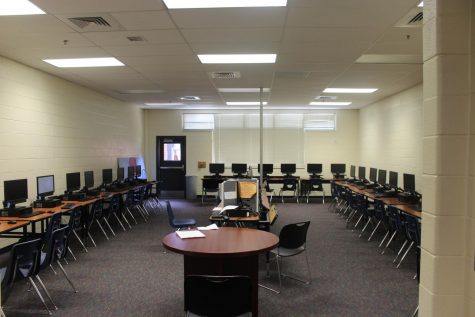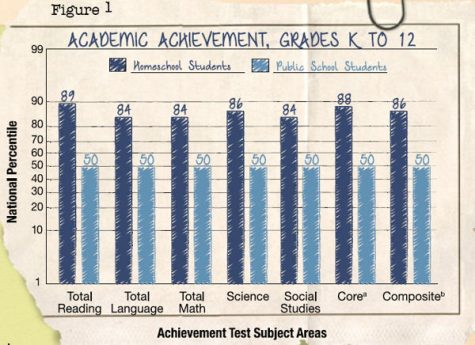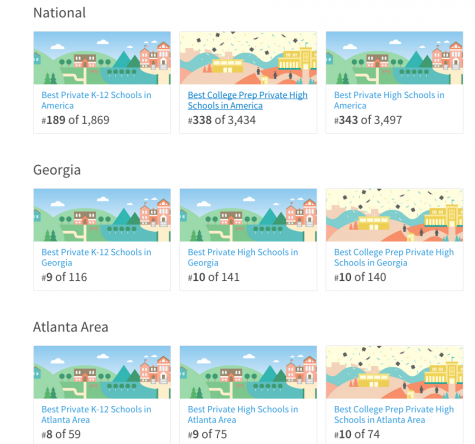Public, Private, Domestic: A parent’s choice to school in America
April 16, 2018
American children tend to hear the praises of education sung to them at an early age, from its foundational proof for how to build your future to securing financial comfort.
Famous civil rights activist Nelson Mandela even once said that education “is the most powerful weapon which you can use to change the world.”
One could reasonably assume that the United States, with the importance of education almost hammered into the minds of its students, outperforms other nations in most all facets of education; however, the global rankings tell a somewhat different story.
 Ashu Ebot-Tabi
Ashu Ebot-Tabi
According to Ranking America, the US from 2012 to 2014 ranked 24th out of 65 in literacy, 2nd out of 14 in social ignorance, and 17th of 40 in overall educational performance. While this might not seem like an issue to most, the exact same ranking show that the lists consistently depict nations like South Korea, Japan, and Hong Kong at the top, with the US underperforming. But why? An article by Myriad blames the public education system, claiming “time is…wasted by infighting and indecision,” while the purportedly important issues like the grading system and secularism remain unsolved.
This dilemma, in addition to falling upon education experts, also befalls parents. However, while the former group must forced to resolve these problems, frequently to no avail, parents can simply opt out and enroll their children in one of the two alternatives to public schooling. First coined in 1754, the Merriam-Webster Dictionary defines private schools as “a school that is established, conducted, and primarily supported by a nongovernmental agency.” In other words, a college for non-college aged students. The second option, homeschooling, largely depends on the guardian of the students, as this system puts the parent in the teaching role, with them dictating what and how the student learns. While the original only applied to high and low income families respectively, both saw an increase in the last decade. The nationwide rates of homeschooling alone “increased from 1.7 percent in 1999 to 3.4 percent in 2012”, an increase from 850,00 to 1.8 million students.
Do these alternative forms surpass the conventional schooling system, or does public school still reign supreme?
The most essential purpose of any form of schooling is, unsurprisingly, to prepare the student for the next level of their education, namely college. As such, the further one progresses throughout secondary school, the more advanced their resources and lessons learned must become. In 2017, of the reported $1.15 trillion dollars spent on public school education from 2012-2013, “92 percent of the funds will come from non-Federal sources”. In contrast, homeschooling generally costs less, as the parents, filling the role of teachers, receive no payment, and resources cost far, far less, with a “bare bones…curriculum for grade 7” costs around $161; one could make an argument that while the quality of materials in public schools falls short, they can potentially acquire superior resources.
Regarding student spending, public schools do hold an immense advantage over homeschools, as the $11,222 spent on public schools considerably outweighs the average $900 spent on homeschooled students. Public schools also outrank private schools, at least on per student spending, with the average per student spending for private school totaling $10,740 per child.
Another important fact to consider regards the environment of the school: will productivity increase, what kind of people will the kids meet, will bullying serve as an issue, etc.? After all, the average American student spends 943 hours in elementary school alone, so letting kids spend that time in a productive environment seems like a logical choice.
Regarding the former, it seems as if private school, specifically boarding schools where students live on campus rather than at home, could definitely raise student productivity.
“I feel that I might perform[better], because since I’d be living at the dorm, there’d be less distractions. It wouldn’t be completely solved, but the chance of it happening would lower, and that’d definitely help,” seventh grader Tabi Ebot-Tabi said.
“Distractions” seems like a vague term, so what could they be? One factor: phones. While the stereotype of inattentive kids clacking away on their phones plays for humor, disturbing trends between the two exist. Time Magazine reported that between 2010 and 2016, the amount of teens that “experienced at least one major depressive episode leapt by 60%.” Other likely candidates for distractors include the presence of food in classes, unpreparedness, and chattiness. None of these trends seem too alarming to homeschoolers, as there are often no other students to talk and distract in class, to come in late, or to pop their chewing gum during assessments.
However, while the lack of other students, in addition to the lack of a bully or someone to treat one poorly, means students will more likely than not retain their focus, the environment they inhabit lacks one major feature compared to public and private schools: other students. Homeschoolers rarely interact with other kids, and this can lead to poor social skills, thus resulting in the stereotype of these kids ending up labeled as antisocial or lacking social skills.
“Homeschooled kids are really isolated and might not develop the necessary social skills to succeed in the future,” senior Sarah Punch said.

Proponents of public schools frequently espouse classroom diversity as one of the greatest advantages to the system; variable class size also comes up frequently.
The topic of school environment tends to top the lists singing the praises of public schools, more specifically the diversity and inclusivity they provide. North Cobb High School alone includes a Black Student Union, a Gay-Straight Alliance, and clubs which increase knowledge of Japanese and German cultures. Student demographics nationwide also match this trend: in 2017, the Pew Research Center reported that “blacks and Hispanics make up 15.5% and 25.4% of the U.S. public school population, respectively.”
“I do think the diversity of public schools is an advantage they have over private schools, since students get to learn to appreciate people from other races, other religions, etc. This has really made my college experience better, because now I don’t see people different from me as bad, but as just people,” college freshman Maia Ebot-Tabi.
In spite of this inclusivity and its potential to expand the perspective of these kids, the public school system does face a national bullying issue. The National Center for Education Statistics reported that 21% of students grades 6-12 faced, with the forms ranging from name calling to damage of personal property. Beyond hurt feelings on the part of the student, links also exist between bullying and negative health risks as well. According to the Suicide Awareness Voices of Education, 1 in 100,000 kids ages 10-14 commit suicide yearly (that number rises to 7 in 100,000 by ages 15-19); likewise, LGBT youth purportedly face a three times higher risk of attempting suicide than their straight counterparts, with said attempts averaging as four times more likely to end up medically serious. Finally, the advent of social media due to platforms like Facebook and Snapchat resulted in a rise in cyberbullying, and subsequent suicides, as cyber harassment cases like that of Phoebe Prince and Tyler Clementi seem more and more common. StatisticBrain reported that 52% of teens both experienced and declined to report their own cyberbullying.
Even students not active on social media see this as a large problem.
“While I’m not a social media user, and neither are my friends, it’s kind of a big deal. We’ve seen movies and stuff about all kinds of bullying in school and numbers about it,” Tabi said.
The area of school environment seems the area in which private schools dominate their rivals. A fairly common tactic of parents whose public-school attending kids face bullied involves shipping them off to private schools. While the reasons for doing so tend to vary between parents, OurKids, a printing company in support of private schools, listed four as the most common for parent:
- A lower average teacher-to-student ratio (12.2 in 2013) means bullying “[will] be less likely to go undetected.”
- The superior surveillance they provide results in more comprehensive monitoring of student activity.
- Private schools more likely than not possess resources to combat bullying, like counseling.
- The more homogeneous nature of private schools means students fit in more naturally.
That last point, though, may not sit well for some. Yes, a student in a Catholic will not face ridicule for his creed, but that lack of individuality can serve as a double edged sword. In a public school, a Native American student can feel somewhat satisfied, knowing they more than likely will see themselves diversely represented. However, the exact opposite applies to private schools, where in 2012, Native Americans comprised less than 1% of the average private school population. And even by disregarding the Native American example, in that same year and study, the Southern Education reported that white students composed the overwhelming majority of private schools at 72.1%. This lack of diversity can also result in a possible sense of bigotry, not growing up in an environment with kids of other backgrounds, a possibility echoed even by private school attendees.
“I prefer public school. The reason is because there’s more diversity and more opportunities[to meet other people],” senior and former private school student Victoria Murphy said.
Most importantly, a school serves one purpose: to teach kids the different subjects they deem appropriate in achieving a successful career in the future. However, while all school systems share this goal, the methods used to achieve it wildly vary, resulting in no two systems appearing exactly alike.

Typically, public computer labs pale in comparison to the sleek, modern design of private schools, as well as the highly individualized nature of their homeschool rivals. Due to schools needing to divert more resources towards certain aspects, public school computers frequently face hardware and software issues.
For public schools, technology usage now seems almost mandatory, with 59% of American classrooms including laptops available for student use; similarly, the employment of tutors saw a rise due to the No Child Left Behind act. However, while these resources do benefit student learning in ways, students do see issues with them.
“The technology is good, but needs to be improved; schoolwide, it’s not bad, but it can be a bit slow, the WiFi isn’t great,and teachers need to schedule around classes for the laptop carts,” senior Sarah Punch said.
On the more extreme side of this perspective, former students consider the public school resources inadequate.
“They [public school resources] were not [sufficient in preparing one for college] at all. The quality of them was subpar at best,and we weren’t even given all the necessary resources, like tutors and technology suited for the work,” Maia said.
This aspect tends to favor private schools. While the technology in public schools can come off as outdated, private schools, because of their higher funding, can afford technology resources on a much higher quality level.
For example, while public schools generally use the commercial internet, private schools use that in addition to Internet 2, which they describe as “the nation’s largest and fastest, coast-to-coast research and education network.” They also possess access to business oriented laptops, in contrast to the more cumbersome desktops of the public school system. Their curriculum also favors them to their public rivals. A common complaint among students, particularly those of high school age, claims that the curriculum teaches unimportant knowledge, while neglecting to instruct students on what would realistically serve them.
“Most of what I’m learning now doesn’t seem to be helpful towards the job I want, which is a video game developer,” Tabi Ebot-Tabi said.
And truth does exist in this claim. While the works of Shakespeare and cell structure hold cultural and scientific importance, respectively, no one can deny that those skills lack the importance of the more tech-based workforce like digital age literacy, global awareness, and data analysis.
Compared to public schools, the curriculum of a private school simply bends more easily. Take the evolution vs. creationism debate, one of the most contested of its kind; numerous court cases, like Selman v. Cobb County School District and Epperson v. Kansas, display the limits of public school curriculum stretching, due to the teaching of the latter conflicting with the Establishment Clause. Private schools, however, never face this issue, as in addition to the majority thereof provide religious education, as their curriculum must face widespread regulation by school charters rather than states means they possess more leeway in what they teach.
Access to resources of this caliber makes it obvious that private school students, due to their superior tech, tutors, and less rigid curriculum, perform on a higher academic level than their public school peers; however, the data would suggest otherwise. A 2009 University of Illinois study showed that public school students tend to“outperform their private-school classmates on standardized math tests.”
One possible reason for this trend: the curriculum. While the rigidity thereof means not all information serves a purpose, the over emphasis on that knowledge lessens the chance of a student encountering an unfamiliar concept. The same sentiment also applied to to test scores, as in the 2003 Nation’s Report Card exam, where “after adjusting for selected student characteristics,” like disability and socioeconomic status, a near zero difference between private and public schools resulted.
The curriculum, for one, may influence this success. While it tends to bend less easily than that of private schools, the more rigid nature of the former means more content ends up covered; for example, in the 2014-2015 school year, the Atlanta Public School system required all students to take 4 units of Language Arts, Science, and Math, 3 of social studies, and 2 units for at least one world language. The variety in these classes required means students, while forced to “cram” to succeed, generally face a lower chance of coming across an unfamiliar concept on an exam.

According to this statistic, in 2009, homeschooled students in the U.S. outperformed their public school contemporaries by a substantial margin, as the 3 subjects with the lowest percentile difference depicted the former scoring an average of 34 percentiles higher.
As for homeschooled kids, their academic performance isn’t as easy to pin down; for one, while they do take tests, those generally come from practice books, and therefore rarely end up placed alongside tests taken by public or private school students. In addition, the data for them that does exist ends up compiled with that of other homeschoolers nationwide, making it difficult to determine statewide academic performance for these kids.
However, data does exist, which depicts a correlation between the two, and the numbers show surprising results. According to the Home School Legal Defense Association, the National Average Percentile Scores for public school students averaged around a 50, while for homeschoolers it came to an 85.4%; this also applies to their test scores, since they rank in the 15-30th percentile in standardized tests, in comparison to the average 50th percentile of public schools.
This also serves as a double-edged sword. Because homeschools only face regulation from parents, the quality of the education can vary wildly from that of private and public schools. While a good chunk of parents will definitely push their kids, not all will, and this can lead to students becoming complacent in their work, knowing their parent lacks the same authority of a professional teacher. Another drawback of the homeschool system pertains to classes offered: the lack of oversight means no one to ensure kids acquire higher level of education, like an AP or Honors.

When asked about her preference of school, senior Victoria Murphy professed to preferring public school, because homeschools “don’t offer AP classes and that level of rigor.”
The choice for the best schooling system, like all choices, never professes a clear, 100% “best solution.”
Multiple factors, even more than listed above, can determine the choice of the parent; all parents should, however, take into account the quasi-subjectivity of the matter. The adage “all students stand apart” may seem like a cliche method to foster individuality in students or prevent discouragement after a poor grade, but this phrase fits just as well into this topic as any other.
Every student needs something from school, and not every school can offer it. Its resources to facilitate academic prosperity, a secure environment, financial levity, the unique nature of these three schooling systems means they can provide all of these and none of them at the same time.
One could say that as long as the student receives an education, the choice does not matter. However, seeing how poorly the U.S. academically performed in the last five or so years, devotion towards the education of the next generation should remain an issue of importance to all.
